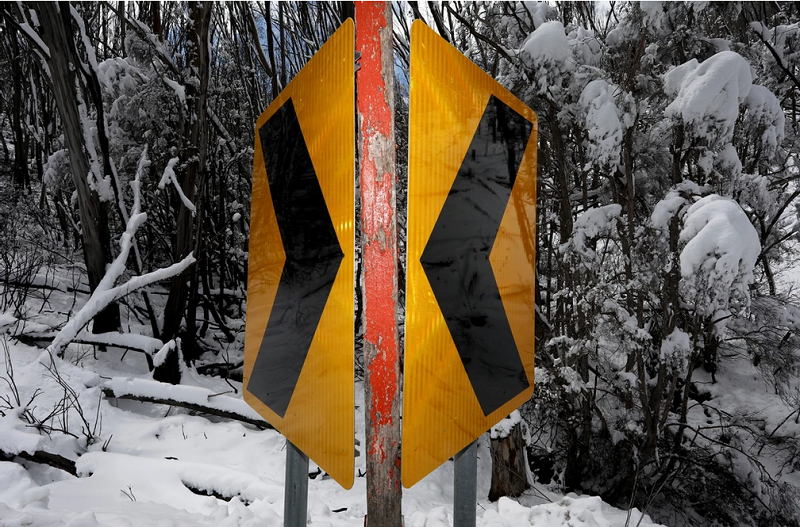
Photography / “Hot/Cold”, at Manuka Arts Centre, until June 15. Reviewed by CORNELIS (CON) BOEKEL.
THIS month PhotoAccess brings together three exhibitions exploring the idea that the world has entered a time of extremes – “climatic, seasonal and perhaps also emotional”.
“Hot/Cold”, the annual hanging of works of members, comprises 41 photos from 21 PhotoAccess members.
Using the hot/cold theme as a single starting point, the photographic outcomes are diverse, with the techniques varying from a traditional family snap to works that stretch the conceptual boundaries of the meaning of photography itself. There are gourmet photo snacks in this smorgasbord.
Ben Kopilow’s “Black Summer 2020: The Aftermath” brings together 18 fine-art digital prints.
In opposition to the tempestuous horrors of the “Black Summer” fires, the bush in Kopilow’s realist post-fire landscape appears to be still, serene and luminous. Here and there a light snow cover suggests an ironic counterpoint to fire.

There is an expressive use of light and shade. The spotted gum trunks in “Blackened Sentinels” glow in a sort of post-fire after-glow and the tracery of leafless dendritic skylines, as in “Ghosts”, is iconic of Australia’s burnt skylines. The autumnal colours are mellow.
Extreme fires intensify evolutionary pressures. Species almost certainly became extinct during the Black Summer fires. The survivors regrow and regroup, seed, spawn, fertilise, hatch, germinate, sprout, and give birth. I see the beginnings of this in the photos of epicormic shoots such as in “New Life at Namadgi”. The landscapes lack human figures, but humanity, through altered temperature and rainfall regimes, is an unseen and pervasive presence. Kopilow’s photos document a moment in time of a vast, dynamic process. Aftermaths have no end. The photos are a visual feast, a memento mori, and a reminder that where there is life, there is hope.
“Avalanche” by Sari Sutton brings together 33 digital inkjet prints. Sutton’s photos directly and expressly focus on the relationship between humanity and the environment. Sutton’s photo ground is a landscape hit by the Black Summer fires and emptied by covid.

The juxtaposition of road signs with the natural environment is one of the leitmotifs of Sutton’s images. One sign is flat on the ground. Some of the signs, as in “Hazard”, are “stranded assets”, still in place, but with nothing “to do” because there are no humans.
Many of the photos have a photo journalistic feel about them. Sutton’s questing eyes are everywhere. I see the roof of a car otherwise buried in snow. Snowflakes ground the images in the here and now. In “Last orders” there is a casual juxtaposition of an interior with condiments ready for the next meal, and a harsher external environment.
In “Fossil” there’s a cloth-shrouded and shuttered “dead” petrol bowser. In “Cleave” the cleft rock reminds the viewer that the intensity of the Black Summer fires drove accelerated spalling and cracking in exposed rocks. In turn this raised concerns about the fate of ancient indigenous rock art in Namadgi. Human figures are absent but the presence of humanity by way of culture, climate change and covid is pervasive.
Some of Sutton’s intellectual, evocative, and visually satisfying photos are mounted on clear Perspex boxes with light and space between the photos and the walls. The result is a feeling that the reality is still up Targangal way, some images have come down from the mountain, have paused briefly during the exhibition, and will then resume their journey – perhaps as if swept away by the general avalanche of human activity.
Instead of extremes, the three exhibitions are generally set in one phase of the new normal – a period of calm between extremes. The emotional responses are contemplative and/or darkly edgy. The photographic results are wonderful.
The photographs are seen to best advantage in the intimate Huw Davies Gallery in the Manuka Arts Centre but are also accessible here.
Who can be trusted?
In a world of spin and confusion, there’s never been a more important time to support independent journalism in Canberra.
If you trust our work online and want to enforce the power of independent voices, I invite you to make a small contribution.
Every dollar of support is invested back into our journalism to help keep citynews.com.au strong and free.
Thank you,
Ian Meikle, editor




Leave a Reply